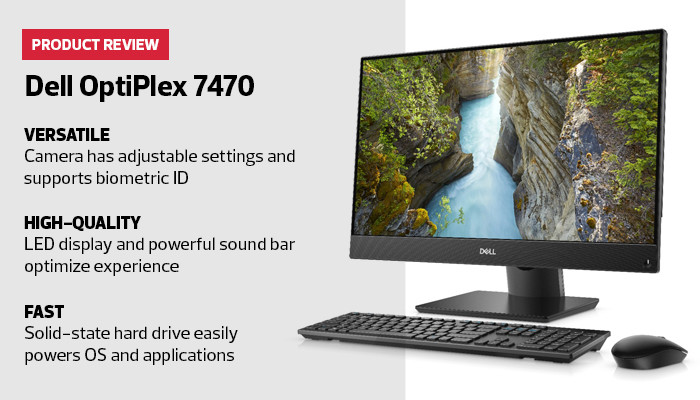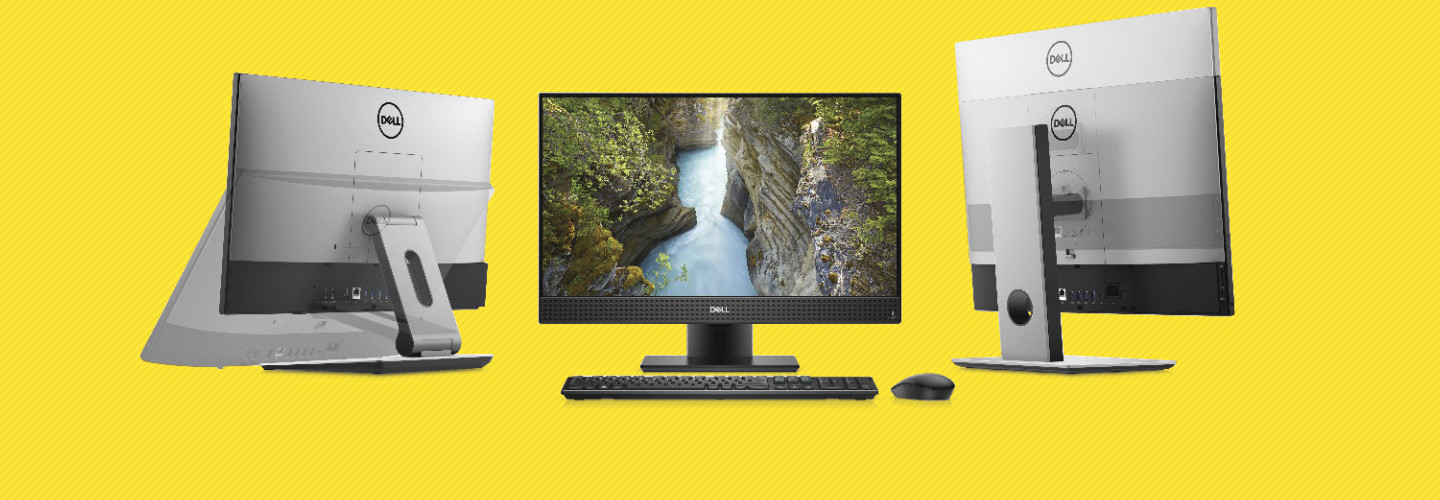Review: Dell OptiPlex 7470 Takes All-in-Ones to a New Level
Programs and applications that support higher education need to run on hardware that’s powerful enough to keep up with not only computing processes but also all of the accompanying graphics and sound effects.
Until very recently, this normally required purchasing individual components, such as sound cards, a large monitor, external equipment like speakers and, of course, a powerful computer. These would then be chained together in a Frankenstein’s monster-style setup — one difficult to effectively achieve and to maintain over time.
A single device that’s capable of doing everything, also known as an all-in-one desktop, isn’t a new concept. They’ve been around for quite a few years. But consolidating everything into a tiny package often meant sacrificing both performance and quality.
Only recently have all the components — ultrafast processors, thin monitors, tiny speakers and solid-state hard drives — come together to make all-in-ones effective and powerful in smaller footprints.
MORE FROM EDTECH: New Dell OptiPlex 7070 Ultra cuts out space, not power.
After Easy Setup, Dell OptiPlex Delivers a User-Friendly Experience
Dell’s new OptiPlex 7470 all-in-one incorporates the latest technology and innovative design. The result is an all-in-one as functional as it is stylish. The model tested has a large, 23.8-inch LED monitor that goes right to the edge of the frame with no bezel. A powerful, advanced speaker bar integrated beneath the display makes everything played through it sound great. Even with all that, the 7470 sits on a small, sturdy stand with a 10-square-inch footprint.
Campus IT teams will have little trouble getting one or several 7470s set up: You simply put the device in place and attach the power cord. The integrated wireless is used for network connectivity, and a spot for a Kensington-type lock slot can be used to prevent physical theft. A 7470 can literally be ready to go in just a few minutes.
In addition, Dell’s device has some of the best performance in its class, including models that are not all-in-ones. With an Intel Core i7 processor and 16 gigabytes of DDR4 RAM, it scored 5,087 on the PassMark Performance Benchmarks, putting it in the 90th percentile of all current-generation professional desktops.
Everything about the 7470 is designed for both flexibility and ease of use. For example, it has a USB-C connection mounted on the side of the monitor for easy access if you need fast file transfers. A separate USB-A port with PowerShare can charge devices like smartphones even if the computer is powered down. The chassis even supports both HDMI 2.0 and DisplayPort for driving extra monitors, projectors and other display devices in highly connected classrooms.
The Dell OptiPlex 7470 all-in-one has all of the power and features needed to drive most educational and business applications. It can even handle programs that are more gamelike, with intense graphics and sound, something that most all-in-ones fail at. There’s little the 7470 can’t do in an educational setting. It’s ready to be enrolled at any campus.
MORE FROM EDTECH: Dell Latitude 3390 two-in-one is a versatile campus tool.

OptiPlex Supports Security and Privacy with Built-In Features
Cybercriminals often view colleges as softer targets than corporations and government agencies. And because institutions hold a wealth of personal and financial information, they are seeing a rise in cyberattacks. The OptiPlex 7470 adds a layer of defense by denying access to unauthorized users and keeping hackers from gaining a foothold on a campus network.
The 7470 is bursting with integrated security features, starting with the chassis itself. The case has chassis intrusion switches tied into the Trusted Platform Module 2.0 security chip. Should anyone try to open the unit to tamper with it, the system will alert either the next valid user or even security personnel. Depending on how it’s configured, the TPM may not even allow the unit to boot until IT staff clear it.
The high-definition camera works great for teleconferences and distance learning but could have become a liability had it not been for the innovative design of the chassis. When needed, the camera pops out of the top of the monitor with a slight push to activate the spring. When not in use, you can store the camera inside. Anyone looking through the camera when it’s locked down will only see a black screen. The camera is also so obvious, like a little eyeball atop the monitor, that it’s easy to see whether it’s ready for action or locked inside the monitor and unable to record.
Another secret to the camera is that it’s both an integrated HD webcam and an infrared camera. The infrared camera means that it will work even in low light conditions, such as dim lecture halls. Both work in conjunction with Windows Hello to add facial recognition as part of the natural login process. When paired with a personal identification number or password, this provides easy two-factor authentication with little setup.
In terms of optional security, our test unit had a Dell MS819 mouse with an integrated fingerprint reader. The ultramodern design has a steep curve in the middle of the unit that’s surprisingly comfortable. Near the top of the curve, an unobtrusive sensor functions as a fingerprint reader for quick logins. Highly secure deployments could combine the fingerprint reader with Windows Hello and a password for three-factor authentication. Even with these layers of protection, activating everything wouldn’t delay authorized faculty or students too much when logging in.
The other optional security feature that came with our test unit was a privacy filter made by 3M for Dell computers that attaches to the display. It’s polarized, so someone looking directly at the monitor can work normally, but anyone seated off-center won’t be able to see or record any images on the screen. This could be a nice addition for desktops used for testing, to prevent students from seeing content on adjacent screens.
These days, security is almost as important as performance. The nice thing about Dell’s protections in the OptiPlex 7470 is that they’re all easy to implement, without being overly taxing on students and staff.
Dell OptiPlex 7470
Processor: Intel Core i7-9700
Display: 23.8-inch InfinityEdge thin-film transistor LED
RAM: 16GB DDR4
Operating System: 64-bit Windows 10 Professional
Hard Drive: 56G solid-state drive
Dimensions: 1.3x13.5x2.1 inches
Weight: 13.32 pounds








